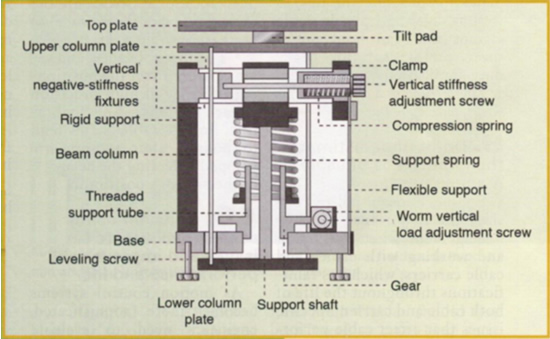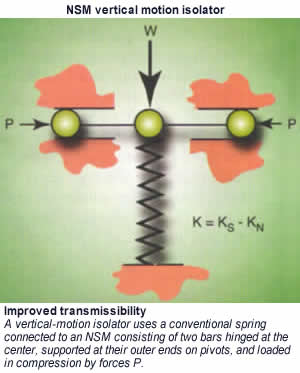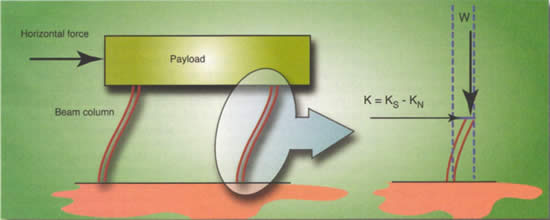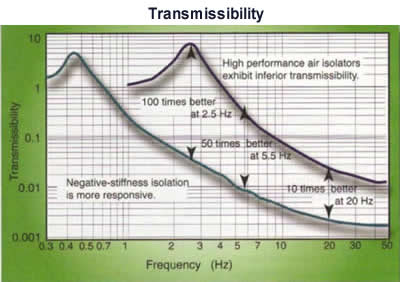
Motion System Design - April 2009
Shake, rattle, roll no more
Negative-stiffness
vibration isolation improves imaging from laser and optical
systems.
Jim McMahon
Dave Kushin
Minus K Technology, Inc. Inglewood, Calif.
Laser and optical systems, whether used in academic labs or
industry, very susceptible to vibrations from the environment
so these instruments frequently need vibration isolation.
They measure a very few angstroms or nanometers of displacement
and need an absolutely stable surface upon which to rest.
Any vibration, coupled into the mechanical structure of the
instrument, causes vertical noise and a fundamental inability
to measure these kinds of high-resolution features.
 As industry continues to broaden
laser and optical research and applications, necessitating
more sensitive equipment and expanded lab facilities,
vibration-handicapped environments will become more prevalent,
and better vibration isolation than what has been available
will be required.
As industry continues to broaden
laser and optical research and applications, necessitating
more sensitive equipment and expanded lab facilities,
vibration-handicapped environments will become more prevalent,
and better vibration isolation than what has been available
will be required.
Negative-stiffness-mechanism or NSM vibration isolation enables
laser and optic instruments such as scanning probe microscopes
or SPMs, micro-hardness testers, and optical profilers to
operate under severe vibration that would otherwise be impractical
with passive and electronic isolation systems. Traditionally,
large air tables are the isolators used for laser and optical
equipment. The ubiquitous passive-system tables, adequate
up until a few years ago, are now being seriously challenged
by the need for more refined imaging requirements. Benchtop
air systems do provide limited isolation vertically and very
little isolation horizontally. However, SPMs, for example,
have unforgiving vibration isolation requirements that are
unparalleled in the laser and optical world.
The vertical axis is the most sensitive for most SPMs. These
systems can also be quite sensitive to vibrations in horizontal
axes. For the lowest possible noise floor, on the order of
an Angstrom, vibration isolation must be used. NSM isolators
have the flexibility of custom tailoring resonant frequencies
vertically and horizontally, providing increased isolation
performance over air tables.
NSM vibration isolator schematic

A vertical stiffness adjustment screw
can regulate compression force on negative-stiffness
flexures. The screw raises or lowers the base of the
support spring in response to varying weight loads to
keep flexures in their straight, unbent operating position.
Flexures are used in the isolators to avoid stiction
and friction.
Similarly, laser-based interferometers also are sensitive devices that must resolve nanometer-sized motion and features. They often have very long mechanical paths that make them even more sensitive to vibrations. The sophisticated modern ellipsometry techniques that allow this high performance rely on low noise to detect fringe movement. Properly isolating an interferometer allows it to provide the highest possible resolution.
 Interferometers and other optical systems
such as optical profilers are often quite complex, and
have long optical paths that can lead to angular magnification
of vibrations. Air tables can make the problems worse
because they have a resonant frequency that often matches
that of floor vibrations - typically 2 to 3 Hz. In addition,
their isolation efficiency is quite limited below about
8 Hz. NSM isolators provide isolation in these environments
when air tables cannot.
Interferometers and other optical systems
such as optical profilers are often quite complex, and
have long optical paths that can lead to angular magnification
of vibrations. Air tables can make the problems worse
because they have a resonant frequency that often matches
that of floor vibrations - typically 2 to 3 Hz. In addition,
their isolation efficiency is quite limited below about
8 Hz. NSM isolators provide isolation in these environments
when air tables cannot.
Negative-stiffness-mechanism vibration isolation systems
have proliferated for laser and optical applications.
Not only is it a workable vibration solution, but it
costs significantly less - to one-third the price of
active and traditional passive systems - making it an
economical component for cost-conscious designers. This
isolation is used internationally, in applications including
nanotechnology, biological sciences, semiconductors,
materials research, zero-g simulation of spacecraft,
and audio for private companies, universities, and government
laboratories.
Negative-stiffness isolators provide transmissibility, vibrations
through the isolator relative to input vibrations. Transmissibility
with negative-stiffness is substantially improved over air
systems, and even over active isolation systems.
Also known as electronic force cancellation, active isolation
uses electronics to sense motion, and then adds forces electronically
to effectively cancel out or prevent it. The efficiency of
active isolation systems is adequate for applications with
the latest lasers and optics as they can start isolating as
low as 0.7 Hz. However, because they ran on electricity, they
can be negatively influenced by problems of electronic dysfunction
and power modulation, which can interrupt scanning. Active
systems also have limited dynamic range that is easy to exceed,
causing the isolator to go into positive feedback and generate
noise underneath the equipment. Although active systems have
fundamentally no resonance, their transmissibility does not
roll off as fast as NSM isolators.
NSM horizontal motion isolator

A horizontal-motion isolation system
is represented by two beam-column isolators. Horizontal
stiffness can be made to approach zero by loading the
beam columns to advance toward critical buckling load.
Negative-stiffness isolators employ a completely mechanical
mechanism for low-frequency vibration isolation. Vertical-motion
isolation is provided by a stiff spring that supports a weight
load, combined with an NSM. The net vertical stiffness is
lowered without affecting the static load-supporting capability
of the spring. Beam columns connected in series with the vertical-motion
isolator provide horizontal-motion isolation. The horizontal
stiffness of the beam-columns is reduced by the "beam-column"
effect. (A beam-column behaves as a spring combined with an
NSM.) The result is a compact passive isolator capable of
very low vertical and horizontal natural frequencies and high
internal structural frequencies. The isolators (adjusted to
1/2 Hz) achieve 93% isolation efficiency at 2 Hz; 99% at 5
Hz; and 99.7% at 10 Hz.
Horizontal and vertical motion isolators
Negative-stiffness mechanism isolators typically use three
isolators stacked in series: a tilt-motion on top of a horizontal-motion
on top of a vertical-motion isolator.
A vertical-motion isolator uses a conventional spring connected
to an NSM consisting of two bars hinged at the center, supported
at their outer ends on pivots, and loaded in compression by
forces P. The spring is compressed by weight W to the operating
position of the isolator. Isolator stiffness is K-Ks- Kn where:
Ks = Spring stiffness
Kn = Magnitude of a negative stiffness, a function of the
length of the bars and the load P. The isolator stiffness
can be made to approach zero while the spring supports the
weight W.
 Transmissibility of the of a passive
negative stiffness vibration isolator - the vibration
that transmits through the isolator as a function of input
vibrations - can be 10 to l00 times better than high-performance
air tables depending on the vibration frequency
Transmissibility of the of a passive
negative stiffness vibration isolator - the vibration
that transmits through the isolator as a function of input
vibrations - can be 10 to l00 times better than high-performance
air tables depending on the vibration frequency
Each isolator behaves like two fixed-free beam-columns loaded
axially by a weight load W. Without the weight load, the beam-columns
have horizontal stiffness Ks. With the weight load, lateral
bending stiffness is reduced by the beam-column effect. This
behavior is equivalent to a horizontal spring combined with
an NSM so that the horizontal stiffness is K = Ks - Kn where
Kn is the magnitude of the beam-column effect. Horizontal
stiffness can be made to approach zero by loading the beam
columns to approach their critical buckling load.
Minus K Technology Inc. develops and manufactures vibration
isolation products based on its patented negative-stiffness-mechanism
technology. For more information, contact Steve Varma at (310)
348-9656 or sales@minmk.com, or visit www.mimisk.com.
Meet the inventor
Dr. David L. Platus is the inventor of negative-stiffness
mechanism vibration isolation systems, founder of Minus K,
and holds over 20 patents related to shock and vibration isolation.
He earned a B.S. and a Ph.D. in Engineering from UCLA, and
a diploma from the Oak Ridge School of (Nuclear) Reactor Technology.
Previously, Platus worked in nuclear, aerospace, and defense
industries conducting and directing analysis and design projects
in structural-mechanical systems. He became an independent
consultant in 1988.